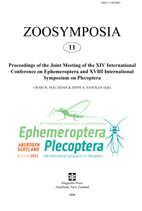Abstract
Larval growth and maturation in aquatic insects are phenotypically plastic and can change in response to the amount and quality of resources, or under predation risk. While better food conditions typically lead to faster growth and earlier maturation at larger body size and hence higher fecundity, the effects of predation risk can vary depending on its strength and selectivity with respect to size or stage. Studies on lotic mayflies (Ephemeroptera) have reported two direct and two indirect life history responses to increased predation risk: slower growth rate and later maturation at the same or smaller size, and faster or unaltered growth rate and earlier maturation at smaller body size. However, life history responses of standing water mayflies to predation risk are unknown. To fill this gap, we carried out a full-factorial laboratory experiment to study the influence of food availability (full/reduced) and predation risk (present/absent predator cues) by dragonfly larvae on growth and maturation of larvae of the lentic mayfly Cloeon dipterum. Males and females responded similarly to food limitation and predation risk. Predation risk had no effect on maturation size, larval mortality and metamorphic failure. However, growth rate, number of moults and development time were all affected by predation risk, and its net effect was modified by food availability and initial body size of the larvae. These results suggest that life history responses to suboptimal conditions depend on body size at the onset of such conditions. Finally, a small group of larvae grew at much slower rates and developed much longer than other individuals of similar initial size, possibly due to bet-hedging or inclusion of multiple genotypes in the experiment.

